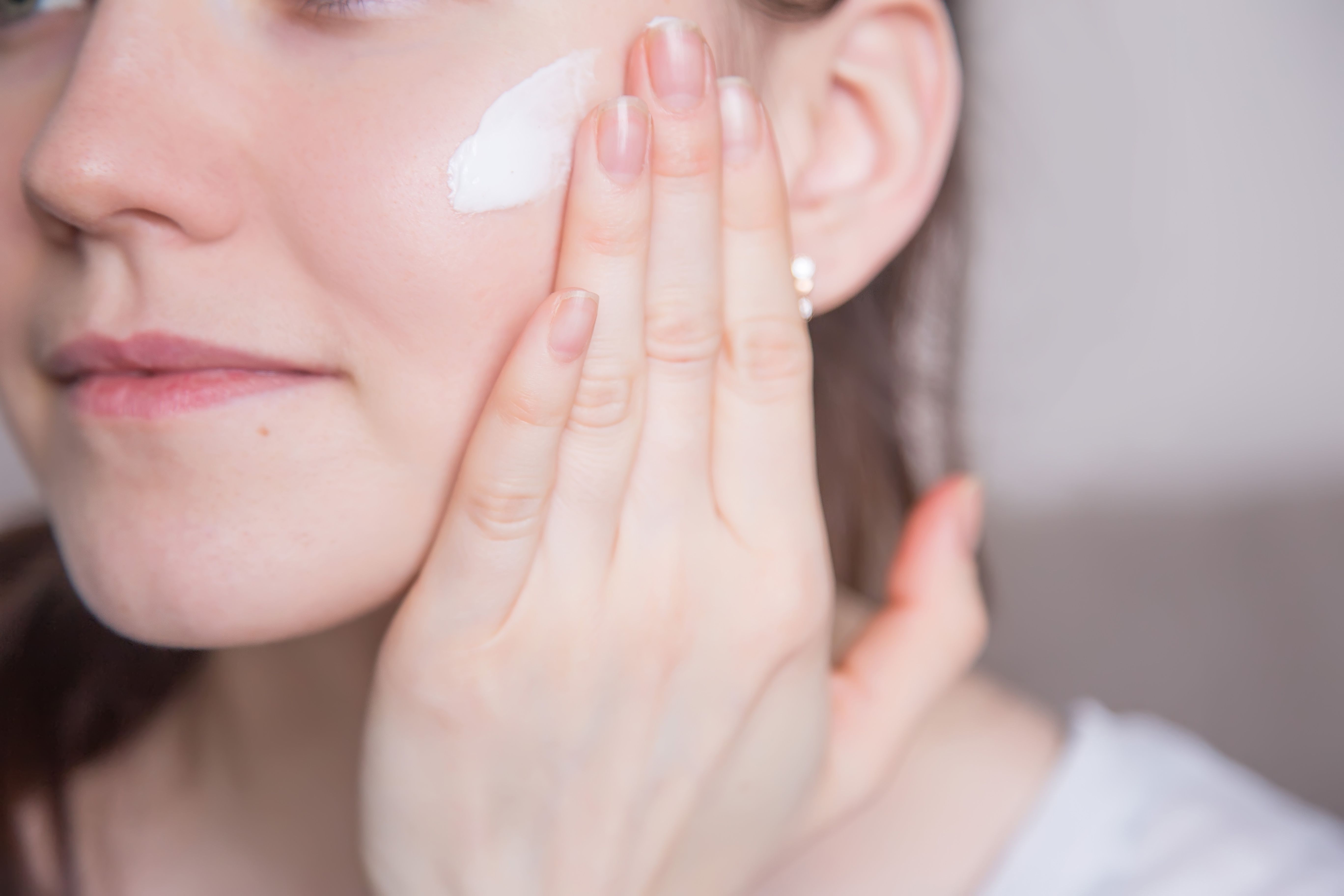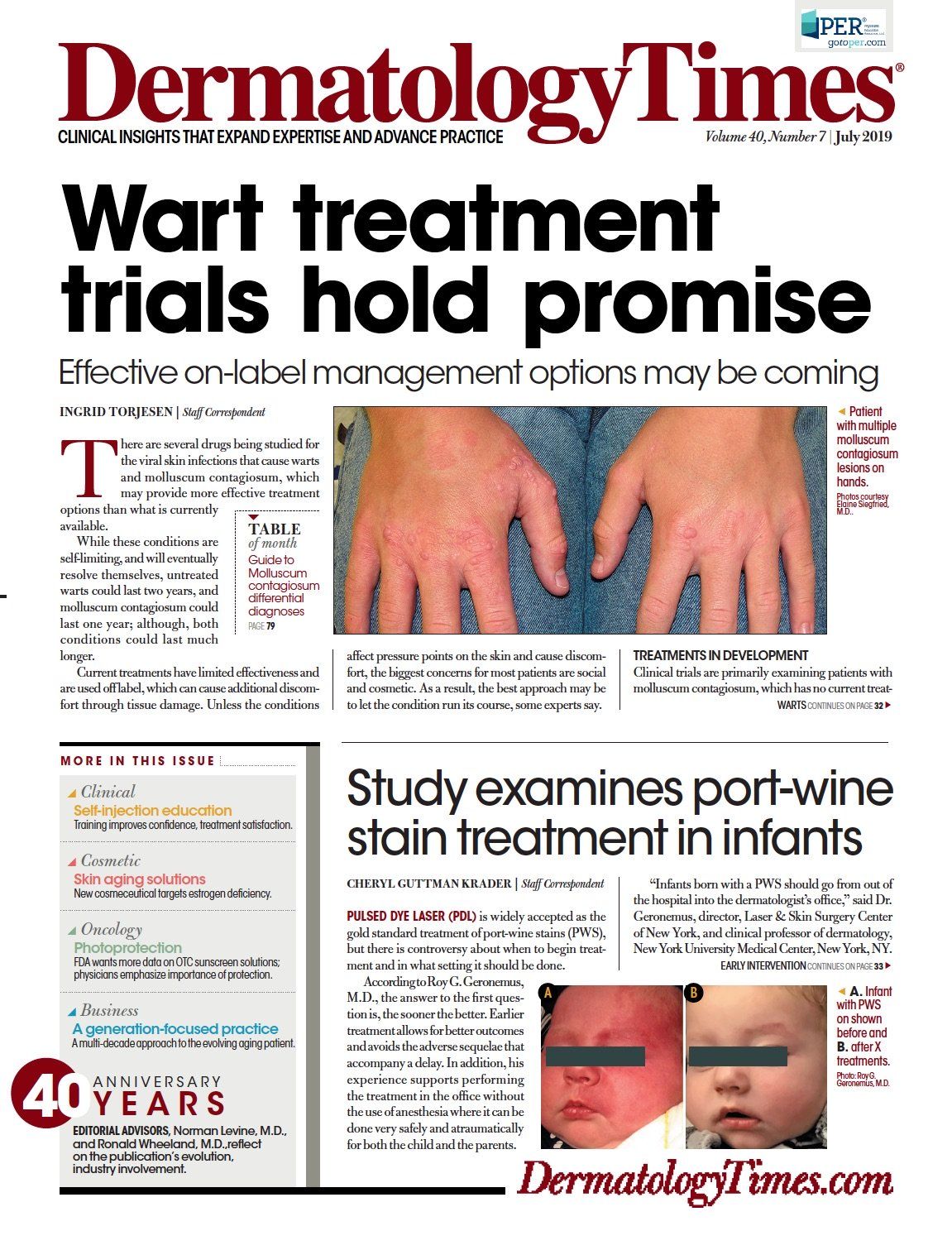- Case-Based Roundtable
- General Dermatology
- Eczema
- Chronic Hand Eczema
- Alopecia
- Aesthetics
- Vitiligo
- COVID-19
- Actinic Keratosis
- Precision Medicine and Biologics
- Rare Disease
- Wound Care
- Rosacea
- Psoriasis
- Psoriatic Arthritis
- Atopic Dermatitis
- Melasma
- NP and PA
- Skin Cancer
- Hidradenitis Suppurativa
- Drug Watch
- Pigmentary Disorders
- Acne
- Pediatric Dermatology
- Practice Management
- Prurigo Nodularis
- Buy-and-Bill
Publication
Article
Dermatology Times
Studies don’t change sunscreen guidance
Author(s):
Sunscreen has been in the news as a recent study found that active ingredients in commercially available sunscreens quickly enter the bloodstream at levels far exceeding the recommended threshold. Still, researchers and physicians are urging Americans to continue using sunscreen, until more is known. These experts explain why.
While the FDA is requesting more data on sunscreen ingredients, they have also been very clear that people should continue to use sunscreen to decrease the risk of skin cancer. (zatevkhi - stock.adobe.com)

Dr. Zeichner

Dr. Laughlin

Sunscreen is in the news. The FDA is proposing researchers, manufacturers and consumers take a hard look at how some sunscreens don’t have the data needed to show they’re safe.1 A recently published paper in the Journal of the American Medical Association (JAMA) suggests that active ingredients in commercially available sunscreens quickly enter the bloodstream at levels far exceeding the recommended threshold.2 And, mainstream media and grassroots bloggers are covering the news with headlines suggesting the products consumers trust to protect their skin might be hurting their health.
Through it all, the U.S. Food and Drug Administration (FDA), American Academy of Dermatology, researchers and physicians are urging Americans to continue using sun protection, including sunscreen, until more is known.
It’s a challenging situation for dermatologists, according to Henry W. Lim, M.D., chair emeritus of the department of dermatology at Henry Ford Hospital in Detroit.
“Dermatologists and the public in general have to make sure not to lose sight of the importance of photoprotection. We all know the side effects of UV exposure, and we know photoprotection does decrease the development of skin cancer,” Dr. Lim says. “We need to continue to emphasize that photoprotection is important and sunscreen is one part but not the only part of photoprotection. We also need to continue to emphasize that while the FDA is requesting more data, the FDA has also been very clear that people should continue to use sunscreen. The data that they got on the JAMA article - the clinical significance of that requires further study.”
FDA’S PROPOSED RULE
In late February 2019, the FDA publicly issued its proposed rule - one it calls a significant action to bring nonprescription, over-the-counter sunscreens that have, until now, largely escaped the FDA’s radar under greater scientific scrutiny. The final rule would impact how industry markets sunscreens.
“The agency is issuing this proposed rule to put into effect final monograph regulations for OTC sunscreen drug products as required by the Sunscreen Innovation Act,” according to the FDA. “OTC monographs establish conditions under which the FDA permits certain OTC drugs to be marketed without approved new drug applications because they are generally recognized as safe and effective (GRASE) and not misbranded.”
ACCORDING TO THE PROPOSED RULE:
Zinc oxide and titanium oxide are the only two of 16 marketed active ingredients, or filters, that are GRASE.
On the other side of the safety spectrum, aminobenzoic acid (PABA) and trolamine salicylate should not be used in sunscreens due to safety issues.
That leaves 12 active sunscreen ingredients: cinoxate, dioxybenzone, ensulizole, homosalate, meradimate, octinoxate, octisalate, octocrylene, padimate O, sulisobenzone, oxybenzone and avobenzone.
There isn’t enough data to classify these as GRASE, so the FDA has published guidances for industry to ensure sun screen manufacturers understand the data FDA needs to evaluate the safety and efficacy of these ingredients.
FDA also proposes GRASE dosage forms for different ways of applying sunscreens, including sprays, oils, lotions, creams, gels, butters, pastes, ointments and sticks.
“Powders are proposed to be eligible for inclusion in the monograph, but additional data are requested before powders can be included in the monograph. Wipes, towelettes, body washes, shampoos and other dosage forms are proposed to be categorized as new drugs because the FDA has not received data showing they are eligible for inclusion in the monograph,” according to FDA.
FDA proposes the maximum SPF value on sunscreen labels be raised to SPF 60+, from SPF 50+. Other issues in the proposed rule address labeling requirements; differentiating products that combine sunscreen and insect repellants as not GRASE; and more.
Steven Wang, M.D., a dermatologist at Memorial Sloan Kettering Cancer Center, says this is a proposed and not a final rule. The FDA was still seeking public comment through June at the time of this publication.
“The FDA is requesting the industry to submit proposed study proposals and results demonstrating the safety. Most of the safety data is looking at absorption and toxicity,” Dr. Wang says.
But the timeline for the data isn’t enough to conduct research, according to Dr. Wang.
“In November of this year, the FDA needs to finalize the monograph on sunscreen, and that puts time pressure on this entire process. These absorption and safety studies take time. It is very doubtful that it can be completed within the next six months. It’s going to take a few years to sort through this process,” Dr. Wang says.
There are a few implications of the proposed ruling in the meantime, according to Dr. Wang. While the FDA is saying there’s insufficient data for safety, consumers should know that doesn’t mean sunscreens are unsafe, he says.
“It’s important to be reminded that sunscreens formulated with these 12 UV filters have been in use for [more than] 30 years. Millions of people are using these products every day. So far, there are no reported systemic side effects,” Dr. Wang says.
Sharyn A. Laughlin, M.D., a dermatologist, who specializes in laser and cosmetic dermatology in Ottawa, Ontario, Canada, says ignoring the FDA’s concerns is akin to putting one’s head in the sand.
Dr. Laughlin says that there are not only strong signs that some sunscreen chemicals harm humans and the environment, but these soluble organic hydrocarbon filters delisted by the FDA have little effect on lowering skin cancer rates.
“Even with avobenzone (the main UVA filter in the group of 12) they give UVB-BIASED protection where the sunscreen transmits up to 10 [times] more UVA than UVB to your skin - similar to the radiation profile of a tanning bed, which every dermatologist knows is carcinogenic. These UVB-BIASED sunscreens have dominated global sunscreen markets for 50 years and paralleled the rise in skin cancer rates that have doubled or tripled in many countries, including North America,” Dr. Laughlin says.
There are perfectly good and safe options in sunscreens if consumers know where to look, says Dr. Laughlin, who is a research consultant to Cyberderm, an Ottawa-based sunscreen company. Dr. Laughlin started Cyberderm in 1995 to research and develop high UVA mineral sunscreens, she says.
Chances are dermatologists won’t learn of UV filters’ harmful effects reading the dermatology literature, according to Dr. Laughlin.
“You have to read the toxicology, environmental and the endocrinology literature. If dermatologists read those studies, they might have a different take on this,” Dr. Laughlin says. “Last time I looked there are over 100 studies in peer-reviewed literature citing adverse effects in humans and wildlife. A 2016 review of 85 scientific papers in humans and lower species concluded that aromatic hydrocarbon UV filters are generally involved in the disruption of the hypothalamic–pituitary–gonadal system.3 More recent studies in 2018 and 2019 confirm that UV hydrocarbon filters, other phenols including the preservative parabens, clearly change levels of virtually every sex hormone, pituitary hormones, thyroid hormones and certain growth factors in both pregnant and non-pregnant women.”
A change in a hormone level is evidence of hormone disruption, according to Dr. Laughlin.
“The numerous clinical consequences are another matter and may not be evident for up to 40 years or more,” she says. “A 2019 publication showed evidence that the [polycyclic aromatic hydrocarbons] PAH UV filters can affect the timing of puberty in boys and girls.4 Physicians must remember the first precept or sacred trust in medicine: first, do no harm. Since the delisted 12 are all bio-available to the fetus, confirmed by the FDA and CDC, there is no way to assess the NOAEL (No Observed Adverse Effect Level) in a fetus.”
Dr. Laughlin says that Danish researchers showed the lethal effects of oxybenzone and 13 of 29 UV filters in an in vitro study on human sperm rendering them unable to fertilize an egg.5 But she admits it’s hard to prove how applying sunscreen might impact a person decades later - how it might impact the health of their unborn children or cause health problems epigenetically.
NEW RESEARCH IN JAMA
Sunscreen active ingredients with systemic absorption above 0.5 ng/mL should undergo nonclinical toxicology assessment, including systemic carcinogenicity and developmental and reproductive studies, according to the FDA.
When researchers studied 24 healthy participants applying four commercially available sunscreen formulations, in spray, lotion and cream formulations, they found the maximum plasma concentrations for avobenzone, oxybenzone, octocrylene and ecamsule (a filter not included in the FDA’s proposed rule) far exceeded the threshold, according to the FDA-funded study published online May 6 in JAMA.2
One glaring example: The geometric mean maximum plasma concentration of oxybenzone was 209.6 ng/ML for one of the sprays. And those in the study who applied sunscreens with oxybenzone had plasma concentrations of more than 0.5 ng/ML within two hours after a single application on the first day, according to the study.
Whether human health suffers with high plasma concentrations of these and other sunscreen chemicals remains unclear. The authors cite research that oxybenzone, oxtocrylene and other active sunscreen ingredients have been found in human breast milk. Oxybenzone has been detected in amniotic fluid, urine and blood and studies have raised questions about whether oxybenzone impacts endocrine activity.
The authors write that their findings are not definitive.
Joshua Zeichner, M.D., a dermatologist at Mount Sinai Hospital in New York, agrees.
“In this preliminary study where high levels of sunscreen were applied to 75% of the body, low levels of chemical sunscreen filters were shown to be absorbed through the skin. In the real world, consumers do not apply as much sunscreen as they should, and they do not reapply every two hours. So, it is unclear whether there is absorption with every day, real world use,” Dr. Zeichner says. “We need more data to understand this issue fully. Based on what we know today, the benefit of wearing sunscreen in protecting the skin against skin cancer and premature aging outweighs the potential risks. If anyone is concerned with the use of chemical blocker sunscreens, mineral options that contain zinc oxide alone or in combination with titanium dioxide are a great option.”
Dr. Wang says the fallout from this controversy could be fewer UV filters available for US sunscreen manufacturers and potentially less sunscreen use among consumers.
“By the time this process is completed we might have fewer filters in the U.S.,” Dr. Wang says. “The industry might say we will not perform the necessary experiments for all 12 UV filters.”
The United States needs more of the UV filters currently available in other parts of the world, Dr. Wang says.
Dr. Laughlin says new technologies are making even some zinc sunscreens more cosmetically pleasing.
“Zinc and titanium sunscreens which are what we call the insoluble, inorganic sunscreen filters, cannot get absorbed into the body,” Dr. Laughlin says.” What has happened over time is the molecules - the zinc itself - is milled very fine and it’s processed. The particles are actually tighter, which gives you better attenuation of light, and they’re not white anymore. They’re actually clear. It’s what we call index matching of the skin, so you see your own skin tone through. And, also, they don’t wash off with the water because they’re adherent to the dead skin.”
There are other newer molecules coming out which are insoluble but are not yet available in the United States, according to Dr. Laughlin.
“They may be carbon-based, but they are insoluble and cannot enter through the skin. They cannot enter into blood. They don’t cross the blood-brain barrier or the placenta to get into the fetus. Plus, they’re excellent filters for UVA,” Dr. Laughlin says. “For example, Tinosorb S and Tinosorb M, which provide UV absorption and reflection. Health Canada just approved those but in concentrations that are pretty low. We’ve formulated a 21% zinc sunscreen with Tinosorb S (1%) and M (9%) at higher concentrations. And that probably has the highest UVA protection factor at 45 in the world.”
For now, Dr. Wang says his message to patients is the same as it has been: “Sun avoidance, seeking shade, clothing, hat, use sunscreen. That sequence of protection has always been consistent.”
Dr. Laughlin says that even people with darker skin should try newer versions of zinc oxide sunscreen.
“Many zinc oxide sunscreens even at 20% to 25% apply clear and do not leave even dark skin looking white,” she says. “People need to use sunscreen, but they need to use good sunscreen with large insoluble UV filters that do not permeate; thereby avoiding all the controversy and bioavailability to the unborn, likely safer for humans and the environment and with higher UVA protection.” Â
Disclosures:
Dr. Laughlin is a shareholder and consultant for The Sunscreen Company (Cyberderm). No disclosures for Dr. Zeichner or Wang. Dr. Lim reports research grants to Henry Ford Hospital from Estee Lauder, Ferndale, Unigen. Dr. Lim is a consultant for Pierre Fabre and ISDIN.
References:
1. Sunscreen Drug Products for Over-the-Counter Human Use. Federal Register Website. https://www.federalregister.gov/documents/2019/02/26/2019-03019/sunscreen-drug-products-for-over-the-counter-human-use. Published February 26, 2019. Accessed May 2019.
2. Matta MK, Zusterzeel R, Pilli NR, et al. Effect of Sunscreen Application Under Maximal Use Conditions on Plasma Concentration of Sunscreen Active Ingredients: A Randomized Clinical Trial. JAMA. 2019;
3. Wang J, Pan L, Wu S, et al. Recent Advances on Endocrine Disrupting Effects of UV Filters. Int J Environ Res Public Health. 2016;13(8)
4. Harley KG, Berger KP, Kogut K, et al. Association of phthalates, parabens and phenols found in personal care products with pubertal timing in girls and boys. Hum Reprod. 2019;34(1):109-117.
5. Rehfeld A, Egeberg DL, Almstrup K, Petersen JH, Dissing S, Skakkebæk NE. EDC IMPACT: Chemical UV filters can affect human sperm function in a progesterone-like manner. Endocr Connect. 2018;7(1):16-25.






